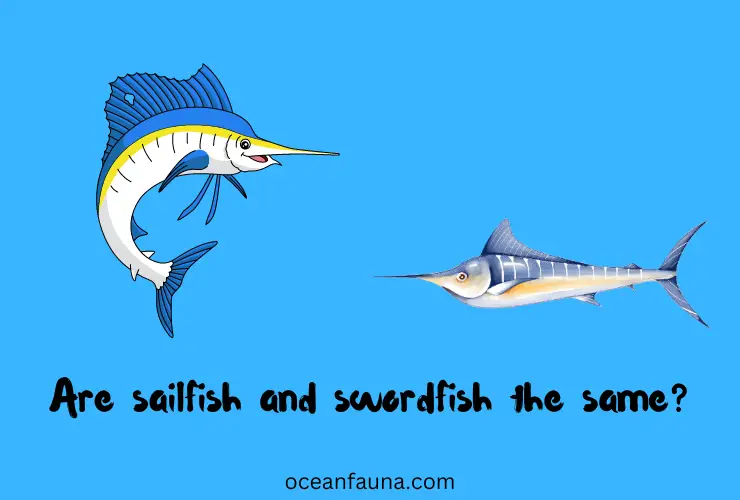No, sailfish and swordfish are not the same. While they both have elongated bodies and sharp bills, sailfish belong to the Istiophoridae family. They are characterized by their high dorsal fin that resembles a sail. The swordfish, however, belong to the Xiphiidae family. They are even known for their long, flat bill that resembles a sword.
Due to their similar names and appearances, sailfish and swordfish often get confused. Hence, it is a common misconception that they are the same fish. But truthfully, they belong to two different species and families.
Among other things, this blog post examines the differences between sailfish and swordfish. I will explore how these two magnificent species are alike, as well as the ways in which they differ.
So sit back, relax, and take a dive into the fantastic world of these magnificent creatures!
Sailfish Vs Swordfish- A Comparison Table
| Sailfish | Swordfish | |
| Scientific name | Istiophorus platypterus | Xiphias gladius |
| Spieces | One | Two |
| length | Up to 11 feet (3.4 meters) in length and | Up to 15 feet (4.6 meters) in length and |
| Weight | 200 pounds (90 kilograms) in weight | 1,400 pounds (650 kilograms) in weight |
| Speed | 68 miles per hour | 60 miles per hour |
| Lifespan | 13 to 15 years | Uo to 16 years |
| Appearance | Slender and streamlined body, long bill, and a sail-like dorsal fin | Elongated, flattened body, long sword-like bill, and two dorsal fins |
| Habitat | Found in tropical and subtropical waters worldwide, usually near the surface | Found in temperate and tropical waters worldwide, usually in deeper waters |
| Temperature | Tolarate much wider range of temperature, 70 degrees Fahrenheit to 83 degrees Fahrenheit. | Tolerate 41-degree farenhiet to 81-degree farenhiet. |
| Feeding | Feeds on small fish and squid near the surface | Feeds on a variety of fish, including mackerel, herring, and squid, usually in deeper waters |
| Sail | Yes | No |
| Teeth | Yes | No |
| Fishing | Often caught as a game fish and released, but also commercially fished for food and bait | Commercially fished for food and sport, but also caught for their sword-like bill and their oil and skin |
| Conservation status | Least Concern (IUCN) | Vulnerable (IUCN) |
Some Key Differences Between Sailfish And Swordfish
Despite some similarities, these two species are different. They differ in habitat and feeding habits, sizes, speeds and many other points. Let’s know the key differential points between sailfish and swordfish.
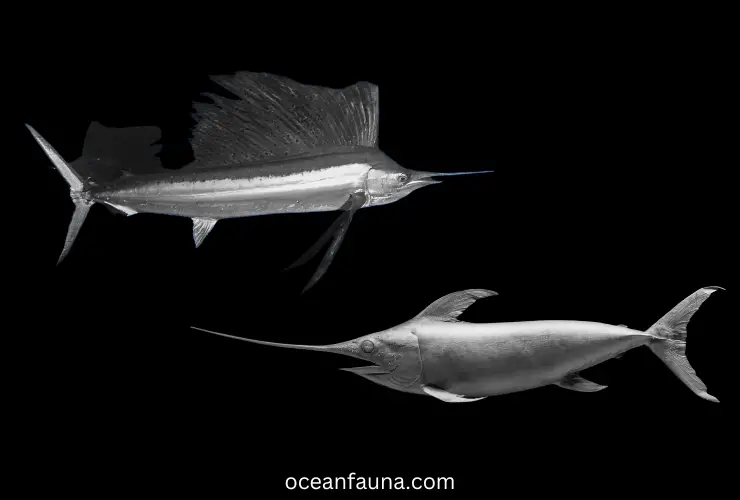
1. Physical appearance
- Body type- Sailfish have streamlined, slender bodies designed for speed and agility. on the other hand, swordfish have a more elongated body shape adapted for powerful swimming.
- Fins- Sailfish have a large dorsal fin that stretches along the length of their body. It gives a distinctive sail-like appearance. In contrast, Swordfish have dorsal fins that are relatively tall.
- Bill- Swordfish have long, flat bills resembling a sword they use to catch prey. There are, however, sailfish with the pointed bill as well.
- Color- A sailfish has a distinctive blue-grey to dark blue back with silvery-white sides and underbelly. Sailfish’s dorsal fins may appear blue, purple, or cobalt blue when threatened or excited.
In contrast, swordfish have dark gray to brownish-black backs, fading to gray or silver on the sides and belly. The bill is usually dark, although it may appear lighter or metallic when lit.
2. Weight
Depending on their age, gender, and other factors, sailfish can have a wide range of weights. Male sailfish weigh approximately 200 pounds (90 kilograms), while females weigh less.
However, some sailfish reach 220 pounds (100 kilograms) or more. Because sailfish are typically caught and released rather than kept for meat. As a result, their weight is rarely officially recorded.
The swordfish can grow to impressive sizes, making them powerful and large fish. Different factors can affect a swordfish’s weight, such as age, gender, and size. Adult swordfish weigh between 150 and 300 pounds (68 to 136 kilograms). Also, the largest specimens can weigh up to 1400 pounds( 650kg). (source)
3. Length
On average, adult sailfish measure between 6 and 10 feet (1.8 and 3 meters) in length from their bills to the tips of their tails. Females tend to be larger than males. In fact, sailfish length can vary based on age and gender.
Adult swordfish can measure between 5 and 9 feet (1.5 to 2.7 meters) from their bills to the tips of their tails. However, some specimens can reach 14 feet (4.3 meters) or more in length. Swordfish have long, sword-like bills as long as one-third of the length of their bodies.
4. Speed
In short bursts, sailfish attain remarkable speeds in the ocean. In fact, they are so fast that they can swim 100 meters in just 4.8 seconds. Their sprinting skills make them true champions. Also, they can swim up to 110 km/h (68 mph).
Swordfish are slower, with a top speed of 80 km/h (50 mph). However, they are renowned for their strength and agility and are among the fastest fish in the ocean.
5. Lifespan
In general, sailfish caught and released by sports fishermen have an average lifespan of 4 to 5 years. However, Sailfish can live up to 13 to 15 years, and they spend most of their time at the surface
In contrast, swordfish live for about 9 to 10 years, depending on environmental conditions and fishing pressure. However, there are some swordfish that live longer than 15 years. The lifespan of swordfish is also affected by overfishing, which is reducing their populations.
6. Reproduction
Sailfish reproduce by spawning, in which females release eggs. Then males fertilize them outside their bodies. The dorsal fins of females attract males, and one female can lay more than a million eggs. When larvae hatch, they take two to three days to reach sexual maturity.
On the other hand, Depending on the region, swordfish spawn year-round or in the spring or summer. It is not uncommon for female swordfish to carry up to 30 million eggs. Even though the eggs are large, they are small, measuring less than 2 millimeters across. After hatching, the larvae are only a few millimeters long.
7. Food habit
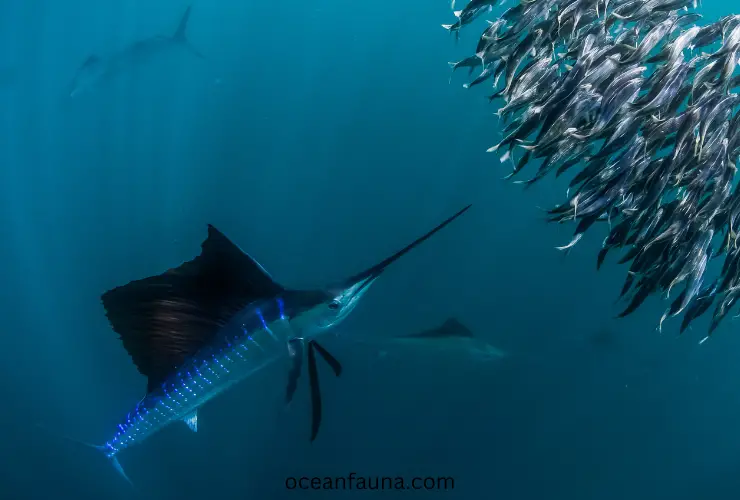
Typically, sailfish eat smaller fish, such as sardines, anchovies, and mackerel, which are predatory. They also feed on squid and octopuses. Sailfish can consume as much as one-third of their own body weight. Their diet may also vary depending on their location and prey availability.
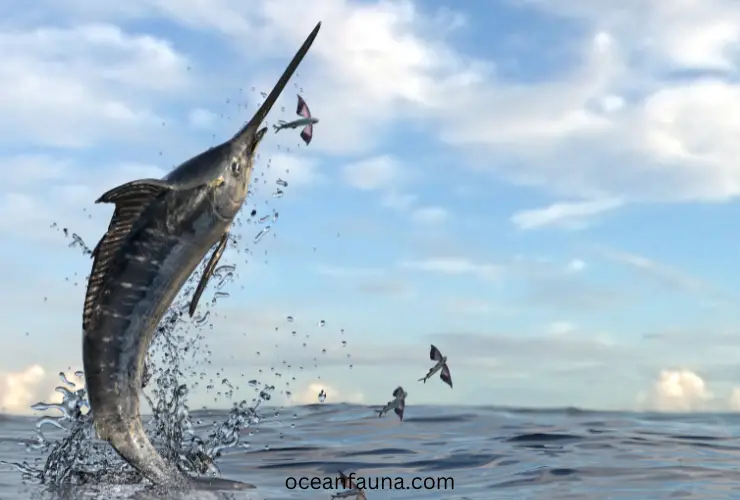
Therefore, swordfish primarily eat cephalopods like squid and octopus and fish like Northern anchovies, Pacific Hake, and mackerel. They also consume some shellfish, although not as much as other types of food. The Bulletin of Marine Science reports swordfish eat primarily cephalopods, followed by fish and shellfish.
8. Distribution
Sailfish are commonly found in the Atlantic Ocean off the coast of Florida, the Gulf of Mexico, and the Caribbean Sea. In addition, the eastern Pacific Ocean extends from Mexico to Peru.
Besides, swordfish are found throughout the world’s oceans. With the largest populations in the Atlantic Ocean.
9. Habitat
Sailfish are found in warmer waters worldwide, especially in the Atlantic and Indian Oceans. They prefer to stay near the water’s surface and are often found in areas with strong currents.
Swordfish are found in deep, warm waters worldwide, particularly in the Atlantic, Pacific, and Indian Oceans. They can tolerate a wide range of water temperatures. Plus, depths are often found in areas with strong currents.
10. Behavior
Swordfish are known for their solitary behavior, often swimming alone in the open ocean. They have been observed jumping out of the water, a behavior known as “breaching,” to dislodge parasites like lampreys. During the spawning season, males may chase females to mate.
Apart from that, swordfish communicate by tapping their bills against each other or flapping their tails. Despite their solitary behavior, they are known for being aggressive and attacking boats.
They live alone or in small groups as adults, though juveniles may reside in larger groups. In search of prey, swordfish usually swim near the water’s surface.
Another notable behavior of swordfish is their seasonal migrations. During the summer months, swordfish are found in temperate and tropical waters.
As the water temperature cools in the fall, they migrate southward. It takes several months for this migration to cover thousands of miles.
Moreover, an interesting aspect of swordfish behavior is their ability to regulate their body temperature. Unlike most fish, swordfish are able to maintain their body temperature above that of the surrounding water.
Are Sailfish And Swordfish Edible?
To be honest, both sailfish and swordfish are edible. As well as being harvested commercially, they are consumed worldwide for their meat.
However, A swordfish’s texture is firm and meaty, and it has a mild flavor like tuna. They are typically sold as steaks or fillets and can be grilled, broiled, baked, or sautéed.
Sailfish are also edible and have a firm, white flesh that is mild in flavor. They are not as commonly consumed as swordfish but are sometimes used in sushi and sashimi.
Sailfish Vs Swordfish: Who Can Change Color?
Well, sailfish have a remarkable ability to change their body color instantly, which is known as physiological color change. In their skin, pigment-containing cells called chromatophores accomplish this feat.
In fact, the pigment appears on the skin’s surface when these cells expand or contract. During hunting, sailfish usually darken their normally bluish-silver lateral sides to almost black.
Due to this darkening, the sailfish blend in with the shadows. Thus, it is harder to detect by prey. Sailfish can also change the intensity of their stripes, which run along their bodies.
It is particularly impressive how sailfish can change color so quickly. Studies have shown that sailfish can change their coloration in as little as four-tenths of a second.
Moreover, color changes in sailfish may facilitate communication between individuals and aid in hunting. Male sailfish use color to signal their intentions to females during courtship or to warn off rival males.
Are Swordfish And Sailfish at Risk?
Yes! They are. In fact, swordfish and sailfish populations are facing a number of threats, both natural and man-made.
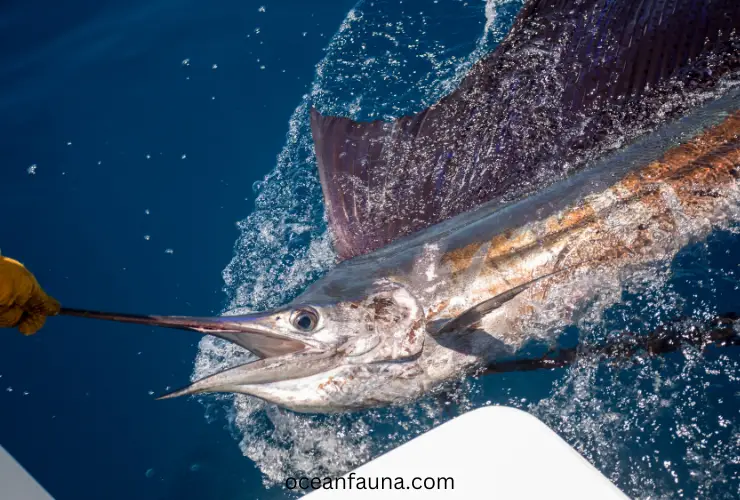
One of the main threats to swordfish and sailfish is overfishing, both for commercial and recreational purposes. These fish are highly valued for their meat, which is considered a delicacy in many parts of the world. As populations decline, their age and size structures change. Overfishing has this effect.
However, swordfish populations have declined significantly over the years due to human fishing. The annual reported catch of North Atlantic swordfish in 2019 amounted to 1.3 million kilograms (2.9 million pounds). (source)
The destruction of habitat is another threat to swordfish and sailfish. Due to coastal development or pollution, they lose their feeding and spawning grounds. As a result of climate change, ocean temperature and acidity can change negatively.
In addition, swordfish and sailfish are also vulnerable to bycatch. It is the unintentional capture of non-target species in fishing gear. The deaths of these fish, sea turtles, and dolphins can result from bycatch.
To address these threats, many countries and international organizations have taken conservation measures. These measures can include fishing quotas, gear restrictions, and protected areas or marine reserves. Consumption of sustainably sourced or certified seafood can help promote sustainable fishing.
FAQs
Are sailfish and swordfish migratory fish?
Yes, it is true that both sailfish and swordfish migrate.
There is evidence that sailfish migrate extensively. Seasonally, they move to different regions in search of food and suitable water temperatures. Even, they are found in warm and temperate oceans.
Unlike sailfish, swordfish also undertake migrations, but their movements are less well understood. They are found in tropical and temperate waters worldwide. Plus, they are known to move between different depths in search of prey.
However, during migration, some populations travel thousands of miles between spawning and feeding ground।
Is sailfish faster than swordfish?
According to the International Game Fish Association, sailfish can reach up to 110 kilometers per hour (68 miles per hour). Nevertheless, other sources indicate that swordfish may be faster, reaching speeds of 100 meters in just 4.8 seconds.
Both sailfish and swordfish have high-speed swimming abilities. It can be challenging to measure a fish’s top speed. However, speed may vary depending on fish age and size, water conditions, and other environmental factors.
Conclusion
Though swordfish and sailfish share similarities. But their physical appearance, habitats, and behaviors differ significantly. From their physical characteristics to their preferred habitats, these two fish are unique in their own right.
So, know the differences between these two fish, especially if you’re planning on catching or cooking them. You will appreciate these majestic creatures more if you understand their unique characteristics.

